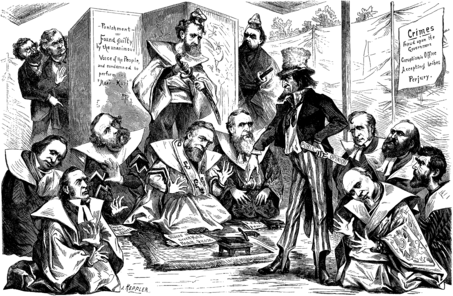Seppuku
Seppuku (Japanese: 切腹, "cutting [the] belly"), sometimes referred to as harakiri (腹切り, "abdomen/belly cutting", a native Japanese kun reading), is a form of Japanese ritual suicide by disembowelment. It was originally reserved for samurai in their code of honor but was also practised by other Japanese people later on to restore honour for themselves or for their families. As a samurai practice, seppuku was used voluntarily by samurai to die with honor rather than fall into the hands of their enemies (and likely be tortured), as a form of capital punishment for samurai who had committed serious offenses, or performed because they had brought shame to themselves. The ceremonial disembowelment, which is usually part of a more elaborate ritual and performed in front of spectators, consists of plunging a short blade, traditionally a tantō, into the belly and drawing the blade from left to right, slicing the belly open.[1] If the cut is deep enough, it can sever the descending aorta, causing a rapid death by blood loss.
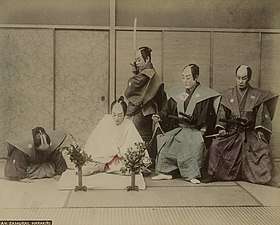
| Seppuku | |||||
|---|---|---|---|---|---|
"Seppuku" in kanji | |||||
| Japanese name | |||||
| Kanji | 切腹 | ||||
| |||||
Etymology
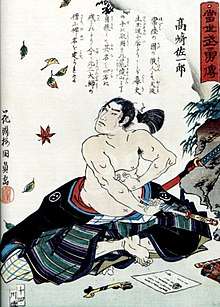
The term seppuku is derived from the two Sino-Japanese roots setsu 切 ("to cut", from Middle Chinese tset) and fuku 腹 ("belly", from MC pjuwk). It is also known as harakiri (腹切り, "cutting the stomach");[2] the term harakiri (often misspelled/mispronounced hiri-kiri or hari-kari by American English speakers[3]) is more familiar to non-Japanese speakers than the term seppuku.[4] Harakiri is written with the same kanji as seppuku but in reverse order with an okurigana. In Japanese, the more formal seppuku, a Chinese on'yomi reading, is typically used in writing, while harakiri, a native kun'yomi reading, is used in speech. Ross notes,
It is commonly pointed out that hara-kiri is a vulgarism, but this is a misunderstanding. Hara-kiri is a Japanese reading or Kun-yomi of the characters; as it became customary to prefer Chinese readings in official announcements, only the term seppuku was ever used in writing. So hara-kiri is a spoken term, but only to commoners and seppuku a written term, but spoken amongst higher classes for the same act.[5]
The practice of performing seppuku at the death of one's master, known as oibara (追腹 or 追い腹, the kun'yomi or Japanese reading) or tsuifuku (追腹, the on'yomi or Chinese reading), follows a similar ritual.
The word jigai (自害) means "suicide" in Japanese. The modern word for suicide is jisatsu (自殺). In some popular western texts, such as martial arts magazines, the term is associated with suicide of samurai wives.[6] The term was introduced into English by Lafcadio Hearn in his Japan: An Attempt at Interpretation,[7] an understanding which has since been translated into Japanese.[8] Joshua S. Mostow notes that Hearn misunderstood the term jigai to be the female equivalent of seppuku.[9]
Overview
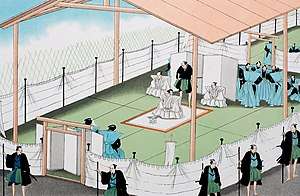
The first recorded act of seppuku was performed by Minamoto no Yorimasa during the Battle of Uji in 1180.[10] Seppuku was used by warriors to avoid falling into enemy hands and to attenuate shame and avoid possible torture. Samurai could also be ordered by their daimyō (feudal lords) to carry out seppuku. Later, disgraced warriors were sometimes allowed to carry out seppuku rather than be executed in the normal manner. The most common form of seppuku for men was composed of the cutting of the abdomen, and when the samurai was finished, he stretched out his neck for an assistant to sever his spinal cord. It was the assistant's job to decapitate the samurai in one swing, otherwise it would bring great shame to the assistant and his family. Those who did not belong to the samurai caste were never ordered or expected to carry out seppuku. Samurai generally could carry out the act only with permission.
Sometimes a daimyō was called upon to perform seppuku as the basis of a peace agreement. This weakened the defeated clan so that resistance effectively ceased. Toyotomi Hideyoshi used an enemy's suicide in this way on several occasions, the most dramatic of which effectively ended a dynasty of daimyōs. When the Hōjō were defeated at Odawara in 1590, Hideyoshi insisted on the suicide of the retired daimyō Hōjō Ujimasa and the exile of his son Ujinao; with this act of suicide, the most powerful daimyō family in eastern Japan was put to an end.
Ritual
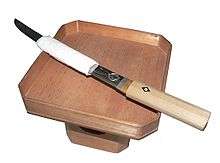
The practice was not standardised until the 17th century. In the 12th and 13th centuries, such as with the seppuku of Minamoto no Yorimasa, the practice of a kaishakunin (idiomatically, his "second") had not yet emerged, thus the rite was considered far more painful. The defining characteristic was plunging either the tachi (longsword), wakizashi (shortsword) or tantō (knife) into the gut and slicing the abdomen horizontally. In the absence of a kaishakunin, the samurai would then remove the blade and stab himself in the throat, or fall (from a standing position) with the blade positioned against his heart.
During the Edo period (1600–1867), carrying out seppuku came to involve a detailed ritual. This was usually performed in front of spectators if it was a planned seppuku, as opposed to one performed on a battlefield. A samurai was bathed, dressed in white robes, and served his favorite foods for a last meal. When he had finished, the knife and cloth were placed on another sanbo and given to the warrior. Dressed ceremonially, with his sword placed in front of him and sometimes seated on special clothes, the warrior would prepare for death by writing a death poem. He would probably consume an important ceremonial drink of sake. He would also give his attendant a cup meant for sake.[11] He would be dressed in the shini-shōzoku, a white kimono worn for death.[12]

With his selected kaishakunin standing by, he would open his kimono, take up his tantō—which the samurai held by the blade with a cloth wrapped around so that it would not cut his hand and cause him to lose his grip—and plunge it into his abdomen, making a left-to-right cut. The kaishakunin would then perform kaishaku, a cut in which the warrior was partially decapitated. The maneuver should be done in the manners of dakikubi (lit. "embraced head"), in which way a slight band of flesh is left attaching the head to the body, so that it can be hung in front as if embraced. Because of the precision necessary for such a maneuver, the second was a skilled swordsman. The principal and the kaishakunin agreed in advance when the latter was to make his cut. Usually dakikubi would occur as soon as the dagger was plunged into the abdomen. The process became so highly ritualised that as soon as the samurai reached for his blade the kaishakunin would strike. Eventually even the blade became unnecessary and the samurai could reach for something symbolic like a fan and this would trigger the killing stroke from his second. The fan was likely used when the samurai was too old to use the blade or in situations where it was too dangerous to give him a weapon.[13]
This elaborate ritual evolved after seppuku had ceased being mainly a battlefield or wartime practice and became a para-judicial institution. The second was usually, but not always, a friend. If a defeated warrior had fought honourably and well, an opponent who wanted to salute his bravery would volunteer to act as his second.
In the Hagakure, Yamamoto Tsunetomo wrote:
From ages past it has been considered an ill-omen by samurai to be requested as kaishaku. The reason for this is that one gains no fame even if the job is well done. Further, if one should blunder, it becomes a lifetime disgrace. In the practice of past times, there were instances when the head flew off. It was said that it was best to cut leaving a little skin remaining so that it did not fly off in the direction of the verifying officials.
A specialized form of seppuku in feudal times was known as kanshi (諫死, "remonstration death/death of understanding"), in which a retainer would commit suicide in protest of a lord's decision. The retainer would make one deep, horizontal cut into his abdomen, then quickly bandage the wound. After this, the person would then appear before his lord, give a speech in which he announced the protest of the lord's action, then reveal his mortal wound. This is not to be confused with funshi (憤死, indignation death), which is any suicide made to state dissatisfaction or protest. A fictional variation of kanshi was the act of kagebara (陰腹, "shadow belly") in Japanese theater, in which the protagonist, at the end of the play, would announce to the audience that he had committed an act similar to kanshi, a predetermined slash to the belly followed by a tight field dressing, and then perish, bringing about a dramatic end.
Some samurai chose to perform a considerably more taxing form of seppuku known as jūmonji giri (十文字切り, "cross-shaped cut"), in which there is no kaishakunin to put a quick end to the samurai's suffering. It involves a second and more painful vertical cut on the belly. A samurai performing jūmonji giri was expected to bear his suffering quietly until he bled to death, passing away with his hands over his face.[14]
Female ritual suicide
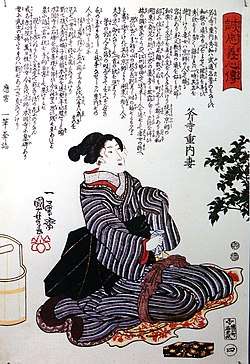
Female ritual suicide (incorrectly referred to in some English sources as jigai), was practiced by the wives of samurai who have performed seppuku or brought dishonor.[15][16]
Some women belonging to samurai families committed suicide by cutting the arteries of the neck with one stroke, using a knife such as a tantō or kaiken. The main purpose was to achieve a quick and certain death in order to avoid capture. Before committing suicide, a woman would often tie her knees together so her body would be found in a dignified pose, despite the convulsions of death. Invading armies would often enter homes to find the lady of the house seated alone, facing away from the door. On approaching her, they would find that she had ended her life long before they reached her.
History
Stephen R. Turnbull provides extensive evidence for the practice of female ritual suicide, notably of samurai wives, in pre-modern Japan. One of the largest mass suicides was the 25 April 1185 final defeat of Taira no Tomomori.[15] The wife of Onodera Junai, one of the Forty-seven Ronin, is a notable example of a wife following seppuku of a samurai husband.[17] A large number of honor suicides marked the defeat of the Aizu clan in the Boshin War of 1869, leading into the Meiji era. For example, in the family of Saigō Tanomo, who survived, a total of twenty-two female honor suicides are recorded among one extended family.[18]
Religious and social context
Voluntary death by drowning was a common form of ritual or honour suicide. The religious context of thirty-three Jōdo Shinshū adherents at the funeral of Abbot Jitsunyo in 1525 was faith in Amida Buddha and belief in rebirth in his Pure land, but male seppuku did not have a specifically religious context.[19] By way of contrast, the religious beliefs of Hosokawa Gracia, the Christian wife of daimyō Hosokawa Tadaoki, prevented her from committing suicide.[20]
Terminology
The word jigai (自害) means "suicide" in Japanese. The usual modern word for suicide is jisatsu (自殺). Related words include jiketsu (自決), jijin (自尽) and jijin (自刃).[21] In some popular western texts, such as martial arts magazines, the term is associated with suicide of samurai wives.[6] The term was introduced into English by Lafcadio Hearn in his Japan: An Attempt at Interpretation,[7] an understanding which has since been translated into Japanese and Hearn seen through Japanese eyes.[8] Joshua S. Mostow notes that Hearn misunderstood the term jigai to be the female equivalent of seppuku.[9] Mostow's context is analysis of Giacomo Puccini's Madame Butterfly and the original Cio-Cio San story by John Luther Long. Though both Long's story and Puccini's opera predate Hearn's use of the term jigai, the term has been used in relation to western japonisme which is the influence of Japanese culture on the western arts.[22]
As capital punishment

While the voluntary seppuku is the best known form, in practice the most common form of seppuku was obligatory seppuku, used as a form of capital punishment for disgraced samurai, especially for those who committed a serious offense such as rape, robbery, corruption, unprovoked murder or treason. The samurai were generally told of their offense in full and given a set time for them to commit seppuku, usually before sunset on a given day. On occasion, if the sentenced individuals were uncooperative or outright refused to end their own lives, seppuku could be carried out by an executioner, or more often, the actual execution was carried out solely by decapitation while retaining only the trappings of seppuku; even the tantō laid out in front of the uncooperative offender could be replaced with a fan (to prevent the uncooperative offenders from using the tantō as a weapon against the observers or the executioner). Unlike voluntary seppuku, seppuku carried out as capital punishment by executioners did not necessarily absolve, or pardon, the offender's family of the crime. Depending on the severity of the crime, all or part of the property of the condemned could be confiscated, and the family would be punished by being stripped of rank, sold into long-term servitude, or executed.
Seppuku was considered the most honorable capital punishment apportioned to samurai. Zanshu (斬首) and sarashikubi (晒し首), decapitation followed by a display of the head, was considered harsher and was reserved for samurai who committed greater crimes. The harshest punishments, usually involving death by torturous methods like kamayude (釜茹で), death by boiling, were reserved for commoner offenders.
Recorded events
On February 15, 1868, eleven French sailors of the Dupleix entered the town of Sakai without official permission. Their presence caused panic among the residents. Security forces were dispatched to turn the sailors back to their ship, but a fight broke out and the sailors were shot dead. Upon the protest of the French representative, financial compensation was paid, and those responsible were sentenced to death. Captain Dupetit Thouars was present to observe the execution. As each samurai committed ritual disembowelment, the violent act shocked the captain, and he requested a pardon, as a result of which nine of the samurai were spared. This incident was dramatised in a famous short story, "Sakai Jiken", by Mori Ōgai.
In the 1860s, the British Ambassador to Japan, Algernon Freeman-Mitford (Lord Redesdale), lived within sight of Sengaku-ji where the Forty-seven Ronin are buried. In his book Tales of Old Japan, he describes a man who had come to the graves to kill himself:
I will add one anecdote to show the sanctity which is attached to the graves of the Forty-seven. In the month of September 1868, a certain man came to pray before the grave of Oishi Chikara. Having finished his prayers, he deliberately performed hara-kiri, and, the belly wound not being mortal, dispatched himself by cutting his throat. Upon his person were found papers setting forth that, being a Ronin and without means of earning a living, he had petitioned to be allowed to enter the clan of the Prince of Choshiu, which he looked upon as the noblest clan in the realm; his petition having been refused, nothing remained for him but to die, for to be a Ronin was hateful to him, and he would serve no other master than the Prince of Choshiu: what more fitting place could he find in which to put an end to his life than the graveyard of these Braves? This happened at about two hundred yards' distance from my house, and when I saw the spot an hour or two later, the ground was all bespattered with blood, and disturbed by the death-struggles of the man.
Mitford also describes his friend's eyewitness account of a seppuku:
There are many stories on record of extraordinary heroism being displayed in the harakiri. The case of a young fellow, only twenty years old, of the Choshiu clan, which was told me the other day by an eye-witness, deserves mention as a marvellous instance of determination. Not content with giving himself the one necessary cut, he slashed himself thrice horizontally and twice vertically. Then he stabbed himself in the throat until the dirk protruded on the other side, with its sharp edge to the front; setting his teeth in one supreme effort, he drove the knife forward with both hands through his throat, and fell dead.
During the Meiji Restoration, the Tokugawa shogun's aide performed seppuku:
One more story and I have done. During the revolution, when the Taikun (Supreme Commander), beaten on every side, fled ignominiously to Yedo, he is said to have determined to fight no more, but to yield everything. A member of his second council went to him and said, "Sir, the only way for you now to retrieve the honour of the family of Tokugawa is to disembowel yourself; and to prove to you that I am sincere and disinterested in what I say, I am here ready to disembowel myself with you." The Taikun flew into a great rage, saying that he would listen to no such nonsense, and left the room. His faithful retainer, to prove his honesty, retired to another part of the castle, and solemnly performed the harakiri.
In his book Tales of Old Japan, Mitford describes witnessing a hara-kiri:[23]
As a corollary to the above elaborate statement of the ceremonies proper to be observed at the harakiri, I may here describe an instance of such an execution which I was sent officially to witness. The condemned man was Taki Zenzaburo, an officer of the Prince of Bizen, who gave the order to fire upon the foreign settlement at Hyōgo in the month of February 1868,—an attack to which I have alluded in the preamble to the story of the Eta Maiden and the Hatamoto. Up to that time no foreigner had witnessed such an execution, which was rather looked upon as a traveler's fable.
In Joseph Ferdinand Keppler's cartoon, published in Frank Leslie's Illustrated Newspaper on March 8, 1873, Uncle Sam is shown directing U.S. Senators implicated in the Crédit Mobilier Scandal to commit Hara-Kiri - clearly showing that by that time the general American public was already familiar with the Japanese ritual and its social implicationsThe ceremony, which was ordered by the Mikado (Emperor) himself, took place at 10:30 at night in the temple of Seifukuji, the headquarters of the Satsuma troops at Hiogo. A witness was sent from each of the foreign legations. We were seven foreigners in all. After another profound obeisance, Taki Zenzaburo, in a voice which betrayed just so much emotion and hesitation as might be expected from a man who is making a painful confession, but with no sign of either in his face or manner, spoke as follows:
I, and I alone, unwarrantably gave the order to fire on the foreigners at Kobe, and again as they tried to escape. For this crime I disembowel myself, and I beg you who are present to do me the honour of witnessing the act.Bowing once more, the speaker allowed his upper garments to slip down to his girdle, and remained naked to the waist. Carefully, according to custom, he tucked his sleeves under his knees to prevent himself from falling backwards; for a noble Japanese gentleman should die falling forwards. Deliberately, with a steady hand, he took the dirk that lay before him; he looked at it wistfully, almost affectionately; for a moment he seemed to collect his thoughts for the last time, and then stabbing himself deeply below the waist on the left-hand side, he drew the dirk slowly across to the right side, and, turning it in the wound, gave a slight cut upwards. During this sickeningly painful operation he never moved a muscle of his face. When he drew out the dirk, he leaned forward and stretched out his neck; an expression of pain for the first time crossed his face, but he uttered no sound. At that moment the kaishaku, who, still crouching by his side, had been keenly watching his every movement, sprang to his feet, poised his sword for a second in the air; there was a flash, a heavy, ugly thud, a crashing fall; with one blow the head had been severed from the body.
A dead silence followed, broken only by the hideous noise of the blood throbbing out of the inert heap before us, which but a moment before had been a brave and chivalrous man. It was horrible.
The kaishaku made a low bow, wiped his sword with a piece of rice paper which he had ready for the purpose, and retired from the raised floor; and the stained dirk was solemnly borne away, a bloody proof of the execution. The two representatives of the Mikado then left their places, and, crossing over to where the foreign witnesses sat, called us to witness that the sentence of death upon Taki Zenzaburo had been faithfully carried out. The ceremony being at an end, we left the temple. The ceremony, to which the place and the hour gave an additional solemnity, was characterized throughout by that extreme dignity and punctiliousness which are the distinctive marks of the proceedings of Japanese gentlemen of rank; and it is important to note this fact, because it carries with it the conviction that the dead man was indeed the officer who had committed the crime, and no substitute. While profoundly impressed by the terrible scene it was impossible at the same time not to be filled with admiration of the firm and manly bearing of the sufferer, and of the nerve with which the kaishaku performed his last duty to his master.
In modern Japan
Seppuku as judicial punishment was abolished in 1873, shortly after the Meiji Restoration, but voluntary seppuku did not completely die out. Dozens of people are known to have committed seppuku since then, including General Nogi and his wife on the death of Emperor Meiji in 1912, and numerous soldiers and civilians who chose to die rather than surrender at the end of World War II. The practice had been widely praised in army propaganda, which featured a soldier captured by the Chinese in the Shanghai Incident (1932) who returned to the site of his capture to perform seppuku.[24]
In 1970, author Yukio Mishima and one of his followers performed public seppuku at the Japan Self-Defense Forces headquarters following an unsuccessful attempt to incite the armed forces to stage a coup d'état. Mishima performed seppuku in the office of General Kanetoshi Mashita. His second, a 25-year-old man named Masakatsu Morita, tried three times to ritually behead Mishima but failed, and his head was finally severed by Hiroyasu Koga, a former kendo champion. Morita then attempted to perform seppuku himself, but when his own cuts were too shallow to be fatal, he gave the signal and was beheaded by Koga.[25]
Notable cases
List of notable seppuku cases in chronological order.
- Minamoto no Tametomo (1170)
- Minamoto no Yorimasa (1180)
- Minamoto no Yoshitsune (1189)
- Hōjō Takatoki (1333)
- Ashikaga Mochiuji (1439)
- Azai Nagamasa (1573)
- Oda Nobunaga (1582)
- Takeda Katsuyori (1582)
- Shibata Katsuie (1583)
- Hōjō Ujimasa (1590)
- Sen no Rikyū (1591)
- Toyotomi Hidetsugu (1595)
- Torii Mototada (1600)
- Tokugawa Tadanaga (1634)
- Forty-six of the Forty-seven rōnin (1703)
- Watanabe Kazan (1841)
- Tanaka Shinbei (1863)
- Takechi Hanpeita (1865)
- Yamanami Keisuke (1865)
- Byakkotai (group of samurai youths) (1868)
- Saigō Takamori (1877)
- Nogi Maresuke and Nogi Shizuko (1912)
- Chujiro Hayashi (1940)
- Kunio Nakagawa (1944)
- Korechika Anami, Takijirō Ōnishi, Isamu Chō, Mitsuru Ushijima (1945)
- Yukio Mishima (1970)
- Isao Inokuma (2001)
In popular culture
The expected honor-suicide of the samurai wife is frequently referenced in Japanese literature and film, such as in Taiko by Eiji Yoshikawa, Humanity and Paper Balloons,[26] and Rashomon.[27] Seppuku is referenced and described multiple times in the 1975 James Clavell novel, Shōgun; its subsequent the 1980 miniseries Shōgun brought the term and the concept to mainstream Western attention. It was staged by the young protagonist in the 1971 dark American comedy Harold and Maude.
In The Last Samurai, a mortally wounded samurai leader Katsumoto performs seppuku with former US Army Captain Nathan Algren's help. This is also depicted en masse in the movie 47 Ronin starring Keanu Reeves when the 47 ronin are punished for disobeying the emperor's orders by avenging their master.[28]
In Season 15 Episode 12 of Law & Order: Special Victims Unit, titled "Jersey Breakdown," a Japanophile New Jersey judge with a large samurai sword collection commits seppuku when he realizes that the police are onto him for raping a 12-year-old Japanese girl in a Jersey nightclub.[29]
In the 2017 revival and final season of the animated series Samurai Jack, the eponymous protagonist, distressed over his many failures to accomplish his quest as told in prior seasons, is then informed by a haunting samurai spirit that he has acted dishonorably by allowing many people to suffer and die from his failures, and must engage in seppuku to atone for them.[30]
In a Tintin adventure named The Blue Lotus, the antagonist, a Japanese named Mitsuhirato, commits seppuku after knowing that his opium smuggling-gang has been destroyed by the main protagonist, Tintin.
See also
|
|
References
- "The Deadly Ritual of Seppuku". Archived from the original on 2013-01-12. Retrieved 2010-03-28.
- "The Free Dictionary". Retrieved 10 November 2013.
- Bryan Garner (27 August 2009). Garner's Modern American Usage. Oxford University Press, USA. p. 410. ISBN 978-0-19-538275-4.
- "Why Do Japanese Commit Hara-Kiri?". Slate. 25 March 1999. Retrieved 25 September 2018.
- Ross, Christopher. Mishima's Sword, p.68.
- Hosey, Timothy (December 1980). "Black Belt: Samurai Women": 47. Cite journal requires
|journal=(help) - Hearn, Lafcadio (2005) [First published 1923]. Japan: An Attempt at Interpretation. p. 318.
- Tsukishima, Kenzo (1984). ラフカディオ・ハーンの日本観: その正しい理解への試み [Lafcadio Hearn's Japan: An Attempt at Interpretation]. p. 48.
- Mostow, Joshua S. (2006). Wisenthal, J. L. (ed.). A Vision of the Orient: Texts, Intertexts, and Contexts of Madame Butterfly, Chapter: Iron Butterfly Cio-Cio-San and Japanese Imperialism. p. 190.
- Turnbull, Stephan R. (1977). The Samurai: A Military History. New York: MacMillan Publishing Co. p. 47. ISBN 0-304-35948-3.
- Gately, Iain (2009). Drink: A Cultural History of Alcohol. New York: Gotham Books. p. 103. ISBN 978-1-59240-464-3.
- Samurai Fighting Arts: The Spirit and the Practice, p. 48, at Google Books
- Fusé, Toyomasa (1979). "Suicide and culture in Japan: A study of seppuku as an institutionalized form of suicide". Social Psychiatry and Psychiatric Epidemiology. 15 (2): 57–63. doi:10.1007/BF00578069.
- "The Fine Art of Seppuku". 19 July 2002. Retrieved 31 March 2014.
- Turnbull, Stephen R. (1996). The Samurai: A Military History. p. 72.
- Maiese, Aniello; Gitto, Lorenzo; dell'Aquila, Massimiliano; Bolino, Giorgio (March 2014). "A peculiar case of suicide enacted through the ancient Japanese ritual of Jigai". The American Journal of Forensic Medicine and Pathology. 35 (1): 8–10. doi:10.1097/PAF.0000000000000070. PMID 24457577.
- Beard, Mary Ritter (1953). The Force of Women in Japanese History. p. 100.
- Turnbull, Stephen (2008). The Samurai Swordsman: Master of War. p. 156.
- Blum, Mark L. (2008). "Death and the Afterlife in Japanese Buddhism". In Stone, Jacqueline Ilyse; Walter, Mariko Namba (eds.). Collective Suicide at the Funeral of Jitsunyo. p. 164.
- Turnbull, Stephen (2012). Samurai Women 1184–1877.
- "じがい 1 0 【自害". goo 辞書.
- Rij, Jan Van (2001). Madame Butterfly: Japonisme, Puccini, and the Search for the Real Cho-Cho-San. p. 71.
- Tales of Old Japan by Algernon Bertram Freeman-Mitford
- Hoyt, Edwin P. (2001). Japan's War: The Great Pacific Conflict. Cooper Square Press. pp. 100–101. ISBN 978-0815411185.
- Sheppard, Gordon (2003). Ha!: a self-murder mystery. McGill-Queen's University Press. p. 269. ISBN 0-7735-2345-6.
excerpt from Stokes, Henry Scott (2000). The Life and Death of Yukio Mishima. Cooper Square Press. ISBN 0-8154-1074-3. - Phillips, Alastair; Stringer, Julian (2007). Japanese Cinema: Texts And Contexts. p. 57.
- Kamir, Orit (2005). Framed: Women in Law and Film. p. 64.
- (47 Ronin)
- ""Law & Order: Special Victims Unit" Jersey Breakdown (TV Episode 2014) - IMDb". Retrieved 7 May 2019.
- "XCVII". Samurai Jack. 2017-04-22. Adult Swim.
Further reading
- Rankin, Andrew (2011). Seppuku: A History of Samurai Suicide. Kodansha International. ISBN 4770031424.
- Yamamoto Tsunetomo (1979). Hagakure: The Book of the Samurai. William Scott Wilson (trans.). Charles E. Tuttle. ISBN 1-84483-594-4.
- Seward, Jack (1968). Hara-Kiri: Japanese Ritual Suicide. Charles E. Tuttle. ISBN 0-8048-0231-9.
- Ross, Christoper (2006). Mishima's Sword: Travels in Search of a Samurai Legend. Da Capo Press. ISBN 978-0-306-81513-3.
- Seppuku - A Practical Guide (tongue-in-cheek)
- Brinckmann, Hans (2006-07-02). "Japanese Society and Culture in Perspective: 6. Suicide, the Dark Shadow". Archived from the original on January 10, 2007.
- Freeman-Mitford, Algernon Bertram (1871). "An Account of the Hara-Kiri". Tales of Old Japan. Archived from the original on 2012-12-06.
- "The Fine Art of Seppuku".
- Zuihoden - The mausoleum of Date Masamune—When he died, twenty of his followers killed themselves to serve him in the next life. They lay in state at Zuihoden
- Seppuku and "cruel punishments" at the end of Tokugawa Shogunate
- Tokugawa Shogunate edict banning Junshi (Following one's lord in death) From the Buke Sho Hatto (1663 AD) --
- "That the custom of following a master in death is wrong and unprofitable is a caution which has been at times given of old; but, owing to the fact that it has not actually been prohibited, the number of those who cut their belly to follow their lord on his decease has become very great. For the future, to those retainers who may be animated by such an idea, their respective lords should intimate, constantly and in very strong terms, their disapproval of the custom. If, notwithstanding this warning, any instance of the practice should occur, it will be deemed that the deceased lord was to blame for unreadiness. Henceforward, moreover, his son and successor will be held to be blameworthy for incompetence, as not having prevented the suicides."
- Fuse, Toyomasa (1980). "Suicide and Culture in Japan: a study of seppuku as an institutionalized form of suicide". Social Psychiatry. 15: 57–63.
External links

- . Encyclopædia Britannica (11th ed.). 1911.
